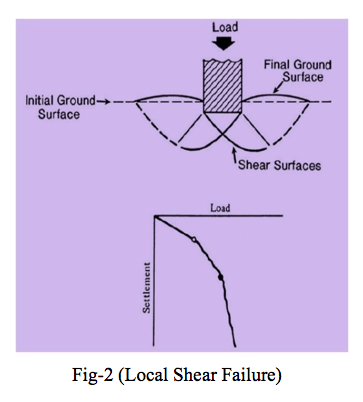A foundation is the element of a structure which connects it to the ground, and transfers loads from the structure to the ground. Foundations are generally considered either shallow or deep foundation.
Very broadly, foundations can be categorised as shallow foundations or deep foundations. Shallow foundations are typically used where the loads imposed by a structure are low relative to the bearing capacity of the surface soils. Deep foundations are necessary where the bearing capacity of the surface soils is insufficient to support loads imposed and so they are transferred to deeper layers with higher bearing capacity.
Types of Foundation Failures and Mechanism
A bearing capacity failure is defined as a foundation failure that occurs when the shear stresses in the soil exceed the shear strength of the soil. Bearing capacity failures of foundations can be grouped into three categories, as follows:
1. General Shear Failure
A general shear failure involves total rupture of the underlying soil. The ultimate bearing capacity has been defined as the bearing stress that causes a sudden catastrophic failure of the foundation.
As shown in Fig-1, a general shear failure ruptures and pushes up the soil on both sides of the footing. For actual failures in the field, the soil is often pushed up on only one side of the footing with subsequent tilting of the structure. A general shear failure occurs for soils that are in a dense or hard state.


2. Local Shear Failure
As shown in Fig-2, local shear failure involves rupture of the soil only immediately below the footing. There is soil bulging on both sides of the footing, but the bulging is not as significant as in general shear. Local shear failure can be considered as a transitional phase between general shear and punching shear. Because of the transitional nature of local shear failure, the bearing capacity could be defined as the first major nonlinearity in the load-settlement curve (open circle) or at the point where the settlement rapidly increases (solid circle). A local shear failure occurs for soils that are in a medium dense or firm state.
3.Punching Shear Failure
A punching shear failure does not develop the distinct shear surfaces associated with a general shear failure. For punching shear, the soil outside the loaded area remains relatively uninvolved and there is minimal movement of soil on both sides of the footing. The process of deformation of the footing involves compression of soil directly below the footing as well as the vertical shearing of soil around the footing perimeter. A punching shear failure occurs for soils that are in a loose or soft state.

The different types of causes that can affect the failure of foundations are uneven loading, overloading, different properties of soil at the foundation interface, insufficient soil compaction, uneven moisture levels and changes in moisture levels of soil beneath the foundation, vibration from adjacent construction and transpiration etc.